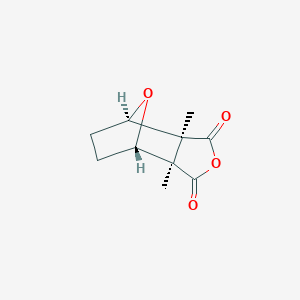| DOT Name |
DOT ID |
UniProt ID |
Mode of Action |
REF |
|
Cytochrome P450 1A1 (CYP1A1)
|
OTE4EFH8
|
CP1A1_HUMAN
|
Increases Expression
|
[6] |
|
Aryl hydrocarbon receptor (AHR)
|
OTFE4EYE
|
AHR_HUMAN
|
Increases Expression
|
[6] |
|
Tumor necrosis factor receptor superfamily member 10A (TNFRSF10A)
|
OTBPCU2O
|
TR10A_HUMAN
|
Increases Expression
|
[4] |
|
Cocaine esterase (CES2)
|
OTC647SQ
|
EST2_HUMAN
|
Decreases Expression
|
[7] |
|
Tumor necrosis factor receptor superfamily member 10B (TNFRSF10B)
|
OTA1CPBV
|
TR10B_HUMAN
|
Increases Expression
|
[4] |
|
Baculoviral IAP repeat-containing protein 5 (BIRC5)
|
OTILXZYL
|
BIRC5_HUMAN
|
Decreases Expression
|
[8] |
|
Serine/threonine-protein kinase/endoribonuclease IRE1 (ERN1)
|
OTY9R6FZ
|
ERN1_HUMAN
|
Increases Expression
|
[4] |
|
Sphingosine 1-phosphate receptor 2 (S1PR2)
|
OTRTJF29
|
S1PR2_HUMAN
|
Increases Expression
|
[7] |
|
Ubiquitin-like modifier-activating enzyme ATG7 (ATG7)
|
OTVT4YA1
|
ATG7_HUMAN
|
Increases Expression
|
[9] |
|
Eukaryotic translation initiation factor 2 subunit 1 (EIF2S1)
|
OTM0GDTP
|
IF2A_HUMAN
|
Increases Expression
|
[9] |
|
Transcription factor Jun (JUN)
|
OTCYBO6X
|
JUN_HUMAN
|
Increases Phosphorylation
|
[4] |
|
Calpain-1 catalytic subunit (CAPN1)
|
OTK6OQZR
|
CAN1_HUMAN
|
Increases Expression
|
[4] |
|
72 kDa type IV collagenase (MMP2)
|
OT5NIWA2
|
MMP2_HUMAN
|
Decreases Expression
|
[10] |
|
Poly polymerase 1 (PARP1)
|
OT310QSG
|
PARP1_HUMAN
|
Increases Cleavage
|
[4] |
|
Apoptosis regulator Bcl-2 (BCL2)
|
OT9DVHC0
|
BCL2_HUMAN
|
Decreases Expression
|
[8] |
|
Endoplasmic reticulum chaperone BiP (HSPA5)
|
OTFUIRAO
|
BIP_HUMAN
|
Increases Expression
|
[4] |
|
Cadherin-1 (CDH1)
|
OTFJMXPM
|
CADH1_HUMAN
|
Increases Expression
|
[10] |
|
Matrix metalloproteinase-9 (MMP9)
|
OTB2QDAV
|
MMP9_HUMAN
|
Decreases Expression
|
[10] |
|
Calpain-2 catalytic subunit (CAPN2)
|
OTIAPE5J
|
CAN2_HUMAN
|
Increases Expression
|
[4] |
|
Cyclic AMP-dependent transcription factor ATF-4 (ATF4)
|
OTRFV19J
|
ATF4_HUMAN
|
Increases Expression
|
[9] |
|
Cyclic AMP-dependent transcription factor ATF-6 alpha (ATF6)
|
OTAFHAVI
|
ATF6A_HUMAN
|
Increases Cleavage
|
[4] |
|
Liver carboxylesterase 1 (CES1)
|
OT9L0LR8
|
EST1_HUMAN
|
Affects Expression
|
[7] |
|
DNA cytosine-5)-methyltransferase 1 (DNMT1)
|
OTM2DGTK
|
DNMT1_HUMAN
|
Decreases Expression
|
[7] |
|
Mitogen-activated protein kinase 3 (MAPK3)
|
OTCYKGKO
|
MK03_HUMAN
|
Increases Phosphorylation
|
[4] |
|
Phosphatidylinositol 3-kinase regulatory subunit alpha (PIK3R1)
|
OT5BZ1J9
|
P85A_HUMAN
|
Decreases Expression
|
[10] |
|
Mitogen-activated protein kinase 1 (MAPK1)
|
OTH85PI5
|
MK01_HUMAN
|
Increases Phosphorylation
|
[4] |
|
Nitric oxide synthase 3 (NOS3)
|
OTLDT7NR
|
NOS3_HUMAN
|
Affects Expression
|
[7] |
|
Nitric oxide synthase 1 (NOS1)
|
OT7M8XVG
|
NOS1_HUMAN
|
Decreases Expression
|
[7] |
|
RAC-alpha serine/threonine-protein kinase (AKT1)
|
OT8H2YY7
|
AKT1_HUMAN
|
Increases Phosphorylation
|
[4] |
|
DNA damage-inducible transcript 3 protein (DDIT3)
|
OTI8YKKE
|
DDIT3_HUMAN
|
Increases Expression
|
[4] |
|
Phosphatidylinositol 4,5-bisphosphate 3-kinase catalytic subunit alpha isoform (PIK3CA)
|
OTTOMI8J
|
PK3CA_HUMAN
|
Decreases Expression
|
[10] |
|
Caspase-3 (CASP3)
|
OTIJRBE7
|
CASP3_HUMAN
|
Increases Expression
|
[11] |
|
Cyclin-dependent kinase 4 inhibitor B (CDKN2B)
|
OTAG24N1
|
CDN2B_HUMAN
|
Affects Expression
|
[10] |
|
Caspase-4 (CASP4)
|
OTVQTV1L
|
CASP4_HUMAN
|
Increases Expression
|
[4] |
|
Tumor necrosis factor ligand superfamily member 10 (TNFSF10)
|
OT4PXBTA
|
TNF10_HUMAN
|
Increases Expression
|
[4] |
|
Caspase-9 (CASP9)
|
OTD4RFFG
|
CASP9_HUMAN
|
Increases Expression
|
[4] |
|
Phosphatidylinositol 3,4,5-trisphosphate 3-phosphatase and dual-specificity protein phosphatase PTEN (PTEN)
|
OTOWDUNT
|
PTEN_HUMAN
|
Increases Expression
|
[10] |
|
Hepcidin (HAMP)
|
OT607RBL
|
HEPC_HUMAN
|
Decreases Expression
|
[12] |
|
Cyclin-dependent kinase 6 (CDK6)
|
OTR95N0X
|
CDK6_HUMAN
|
Decreases Expression
|
[4] |
|
E3 ubiquitin-protein ligase Mdm2 (MDM2)
|
OTOVXARF
|
MDM2_HUMAN
|
Decreases Expression
|
[10] |
|
Apoptosis regulator BAX (BAX)
|
OTAW0V4V
|
BAX_HUMAN
|
Increases Expression
|
[8] |
|
Endonuclease G, mitochondrial (ENDOG)
|
OT5IM7B3
|
NUCG_HUMAN
|
Increases Expression
|
[4] |
|
Beclin-1 (BECN1)
|
OT4X293M
|
BECN1_HUMAN
|
Increases Expression
|
[9] |
|
Ubiquitin-like-conjugating enzyme ATG3 (ATG3)
|
OT28VBVK
|
ATG3_HUMAN
|
Increases Expression
|
[9] |
|
Eukaryotic translation initiation factor 2-alpha kinase 3 (EIF2AK3)
|
OT0DZGY4
|
E2AK3_HUMAN
|
Increases Expression
|
[9] |
| ------------------------------------------------------------------------------------ |
|
|
|
|


